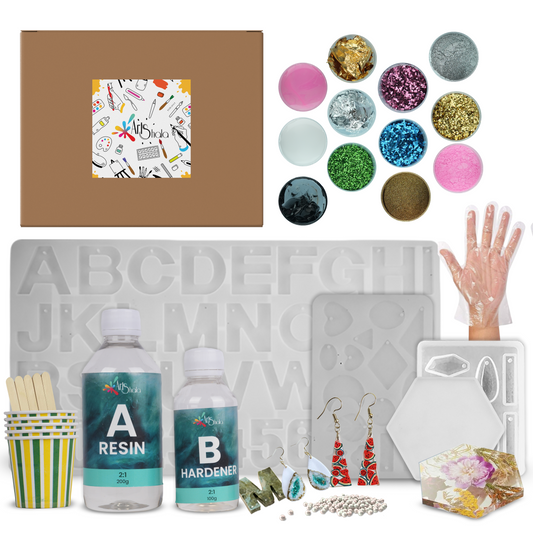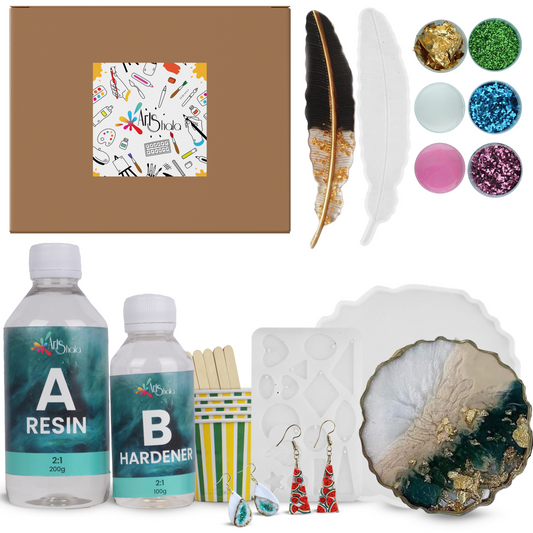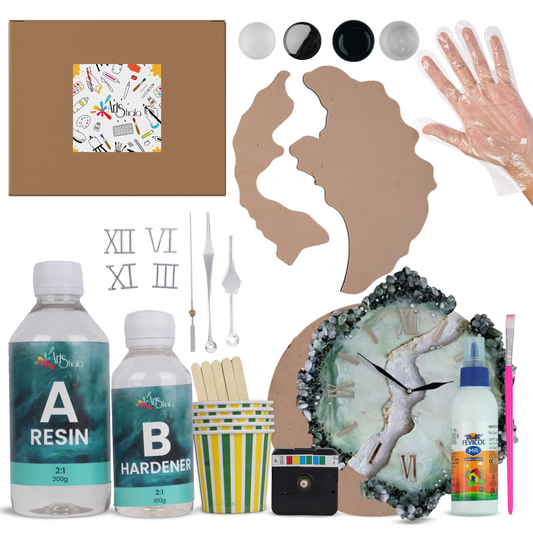Is it Possible to Get Epoxy Resin That Doesn't Yellow Over Time?
Epoxy resin is a popular choice for many applications due to its durability, versatility, and glossy finish. However, one common issue that epoxy resin users encounter is yellowing over time. This yellowing can have a significant impact on the appearance of the finished product, leading to frustration and disappointment. Consider joining an online resin art course where you can learn more about how epoxy resin works and discover techniques to prevent yellowing in your artwork.
In this blog, we will get into the factors that contribute to epoxy resin yellowing and explore whether it is possible to find a solution in the form of epoxy resin that doesn't yellow over time. By understanding the causes of yellowing and exploring innovative techniques used by companies like Arts Shala, we can gain insights into how to prevent or minimise this issue.
Understanding the Causes of Epoxy Resin Yellowing
Epoxy resin yellowing over time is a common issue that can impact the appearance of various projects, such as artwork, furniture, and countertops. Several factors contribute to the yellowing process, including oxidation, UV light exposure, heat, humidity, and the quality of raw materials used.
Oxidation
Oxidation is a chemical reaction that occurs when epoxy resin comes into contact with oxygen. This reaction leads to the breakdown of certain chemical bonds in the resin, resulting in a yellowish discolouration. Over time, the degree of yellowing can increase as more oxygen interacts with the epoxy.
UV Light Exposure
UV light from the sun or artificial sources can accelerate the yellowing process of epoxy resin. The energy from UV rays causes free radicals to form within the resin, leading to colour changes. This is particularly noticeable in areas exposed to direct sunlight.
Heat and Humidity
High temperatures and humidity levels can also contribute to epoxy resin yellowing. Heat speeds up chemical reactions, including oxidation, which can cause the resin to turn yellow more quickly. Humidity can introduce moisture into the resin, leading to discolouration and degradation over time.
Raw Materials Quality
The quality of raw materials used in epoxy resin production plays a crucial role in its resistance to yellowing. Cheaper raw materials may contain impurities or have lower UV resistance properties, making them more prone to discolouration. On the other hand, premium raw materials with high UV resistance can help minimise yellowing and maintain colour stability.
Examining Arts Shala's Approach to Prevent Yellowing
Our comprehensive approach to tackling the yellowing issue goes beyond formulation to include ongoing research and development efforts. We demonstrated a commitment to addressing the challenge of epoxy resin yellowing through a various approach. The emphasis on continuous research and development sets them apart in the industry. Here are key aspects of the strategies:
- Innovative Formulation: We devoted resources to developing advanced formulations that prioritise resistance to yellowing. By focusing on the chemical composition of their epoxy resins, they aim to minimise the impact of environmental factors that contribute to discolouration.
- Quality Control: The company places significant emphasis on stringent quality control measures throughout the production process. This ensures that their epoxy resins maintain high standards of colour stability and durability.
- Investment in R&D: Our investment in research and development underscores their proactive stance in combating yellowing. By staying abreast of technological advancements and scientific discoveries, they strive to enhance the longevity and aesthetic appeal of their products.
- Collaborative Partnerships: The company actively collaborates with experts in material science, chemistry, and related fields to gain insights that inform their approach to preventing resin yellowing.
Preventive Measures: Packaging, Storage, and Environment Control
When it comes to preventing epoxy resin from yellowing over time, it's essential to consider not only the formulation but also the packaging, storage, and environmental factors. Here are some key preventive measures to keep in mind:
Specialised Packaging Features
Italian metal containers and double-seal caps play a crucial role in slowing down the yellowing process of epoxy resin. These specialised packaging features provide better protection against external factors such as UV light, heat, and humidity, which can accelerate yellowing.
Ideal Storage Conditions
Proper storage is essential for maintaining the colour stability of epoxy resin. Storing the resin in a cool, dark place can help minimise exposure to UV light and prevent discolouration over time. Additionally, ensuring consistent temperature and humidity levels in the storage area can contribute to preserving the resin's original appearance.
Environmental Control
Controlling the environment where epoxy resin is stored or used is another important factor in preventing yellowing. Limiting direct or indirect exposure to UV light can significantly impact the long-term colour stability of the resin. By minimising environmental factors, such as heat and humidity, you can help prolong the aesthetic integrity of the epoxy resin.
Preventing Yellowing: Tips and Techniques
Preventing yellowing in epoxy resin can be achieved through various techniques and precautions. Resin artists can take proactive measures to minimise or prevent yellowing in their works, ensuring the long-term clarity and colour stability of their resin art pieces. Here are some practical tips to help prevent epoxy resin yellowing:
- Work in a UV-protected Environment: UV light exposure is one of the main factors that accelerate the yellowing process in epoxy resin. By working in a UV-protected environment, such as a studio with minimal sunlight or using UV-blocking curtains or films on open windows, you can reduce the resin's exposure to harmful UV rays.
- Apply a Topcoat of UV Protection: Adding a layer of protection on top of your cured resin piece can help prevent yellowing over time. Consider applying a topcoat that contains UV protection, specifically designed to block UV light and minimise colour degradation.
- Mix in UV-Resistant Pigments: Another effective way to enhance colour stability is by incorporating UV-resistant additives or pigments into your epoxy resin mixture. These additives act as protective barriers against UV light, reducing the impact of oxidation and yellowing.
Conclusion
While it may be challenging to find epoxy resin that remains truly non-yellowing over an extended period, there are preventive measures and high-quality products available that can help minimise the yellowing process.
Investing in UV-resistant epoxy resins is a crucial step in ensuring long-term colour stability. These resins are formulated with premium raw materials that have high UV resistance properties, making them less susceptible to yellowing caused by exposure to sunlight.
If you're interested in learning more about resin art and how epoxy resin works, Contact Us to join Arts Shala, where you can gain further knowledge and skills in this captivating medium. Remember that while it may not be entirely possible to prevent yellowing altogether, you can certainly take steps to minimise its impact and prolong the lifespan of your epoxy resin projects.












